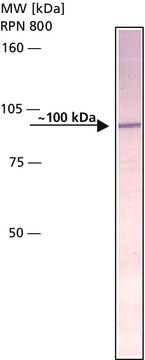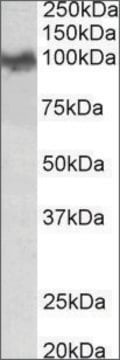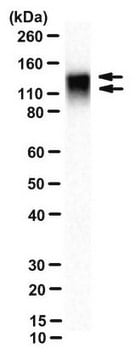MAB349
Anti-Amyloid Precursor Protein Antibody, A4(695), clone 1.D5
clone 1.D5, Chemicon®, from mouse
Synonym(s):
Alz-90
Sign Into View Organizational & Contract Pricing
All Photos(1)
About This Item
UNSPSC Code:
12352203
eCl@ss:
32160702
NACRES:
NA.41
Recommended Products
biological source
mouse
Quality Level
antibody form
purified immunoglobulin
antibody product type
primary antibodies
clone
1.D5, monoclonal
species reactivity
human, rat
manufacturer/tradename
Chemicon®
technique(s)
western blot: suitable
isotype
IgG1
NCBI accession no.
UniProt accession no.
shipped in
wet ice
target post-translational modification
unmodified
Gene Information
human ... APP(351)
Specificity
Reacts with the natural amyloid precursor protein A4(695).
Immunogen
Epitope: A4(695)
Synthetic peptide Alz 90 [amino acids 511-608 of amyloid precursor protein pre A4(695)].
Application
Research Category
Neuroscience
Neuroscience
Research Sub Category
Neurodegenerative Diseases
Neurodegenerative Diseases
This Anti-Amyloid Precursor Protein Antibody, A4(695), clone 1.D5 is validated for use in WB for the detection of Amyloid Precursor Protein.
Western blot: 10-20 μg/mL
Optimal working dilutions must be determined by the end user.
Westen Blot Protocol for MAB349
1) After blotting the SDS-PAGE gel onto nitrocellulose, incubate at room temperature for one hour in 1% PBS in 0.1 mol/L PBS, pH 7.2, to block non-specific background.
2) Incubate the Western blot with MAB349 (10-20 μg/mL) at +4°C overnight shaking well.
3) Wash the Western blots 2 times in PBS-Tween 0.05% for ten minutes. Wash one time in PBS.
4) Incubate the blots with anti-Mouse IgG (Chemicon AP124) for one hour at room temperature.
5) Repeat step #3.
6) Incubate in peroxidase-anti-peroxidase [PAP] (Chemicon PAP14) according to manufacturers directions.
7) Repeat step #3.
8) Incubate in 4-chloro-1-napthol for twenty minutes at room temperature.
9) Repeat step #3.
Optimal working dilutions must be determined by the end user.
Westen Blot Protocol for MAB349
1) After blotting the SDS-PAGE gel onto nitrocellulose, incubate at room temperature for one hour in 1% PBS in 0.1 mol/L PBS, pH 7.2, to block non-specific background.
2) Incubate the Western blot with MAB349 (10-20 μg/mL) at +4°C overnight shaking well.
3) Wash the Western blots 2 times in PBS-Tween 0.05% for ten minutes. Wash one time in PBS.
4) Incubate the blots with anti-Mouse IgG (Chemicon AP124) for one hour at room temperature.
5) Repeat step #3.
6) Incubate in peroxidase-anti-peroxidase [PAP] (Chemicon PAP14) according to manufacturers directions.
7) Repeat step #3.
8) Incubate in 4-chloro-1-napthol for twenty minutes at room temperature.
9) Repeat step #3.
Physical form
Format: Purified
Liquid in 0.02M Phosphate buffer, 0.25M NaCl, pH 7.6 with 0.1% sodium azide.
Storage and Stability
Maintain lyophilized material at +2-8°C for up to 12 months. After reconstitution maintain frozen at -20°C in undiluted aliquots for up to 6 months. Avoid repeated freeze/thaw cycles.
Other Notes
Concentration: Please refer to the Certificate of Analysis for the lot-specific concentration.
Legal Information
CHEMICON is a registered trademark of Merck KGaA, Darmstadt, Germany
Disclaimer
Unless otherwise stated in our catalog or other company documentation accompanying the product(s), our products are intended for research use only and are not to be used for any other purpose, which includes but is not limited to, unauthorized commercial uses, in vitro diagnostic uses, ex vivo or in vivo therapeutic uses or any type of consumption or application to humans or animals.
Not finding the right product?
Try our Product Selector Tool.
recommended
Product No.
Description
Pricing
Storage Class Code
10 - Combustible liquids
WGK
WGK 2
Flash Point(F)
Not applicable
Flash Point(C)
Not applicable
Certificates of Analysis (COA)
Search for Certificates of Analysis (COA) by entering the products Lot/Batch Number. Lot and Batch Numbers can be found on a product’s label following the words ‘Lot’ or ‘Batch’.
Already Own This Product?
Find documentation for the products that you have recently purchased in the Document Library.
Christine Villegas et al.
Human molecular genetics, 23(6), 1631-1643 (2013-11-10)
The amyloid-β precursor protein (APP), a type I transmembrane protein genetically associated with Alzheimer's disease, has a complex biology that includes proteolytic processing into potentially toxic fragments, extensive trafficking and multiple, yet poorly-defined functions. We recently proposed that a significant
Virgil Muresan et al.
The Journal of neuroscience : the official journal of the Society for Neuroscience, 29(11), 3565-3578 (2009-03-20)
The amyloid-beta (Abeta) precursor protein (APP), a transmembrane protein that undergoes proteolytic cleavage into defined fragments, has been implicated in axonal transport. The proposed role of APP as a vesicle receptor for the microtubule motor kinesin-1 has relevance for the
Our team of scientists has experience in all areas of research including Life Science, Material Science, Chemical Synthesis, Chromatography, Analytical and many others.
Contact Technical Service








